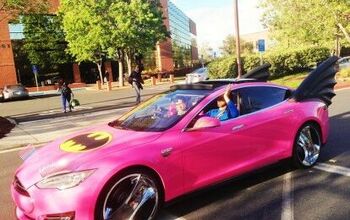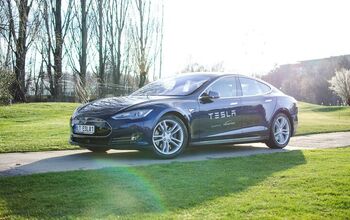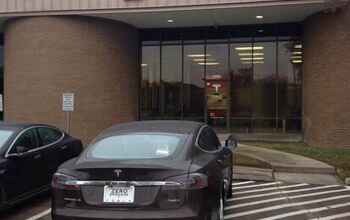Capsule Review: 2014 Tesla Model S P85+

Electric vehicles tend to get a pass from many reviewers, who are content to overlook major faults in favor of a great drivetrain. Years back, I did a review of the Nissan Leaf for EcoModder, an eco-enthusiasts site dedicated to fuel-friendly modifications and electric vehicle (EV) projects. In retrospect, I was far more impressed with the fact that it was just an electric car than the car itself. A Leaf is still a rebodied Nissan Versa with illusions of green responsibility. It’s neat, but it’s not that outstanding if you look at it simply as another car.
The brakes are mean stompers, aided by the regen braking in the rear. Though very heavy, you almost never feel the weight; it’s too low in the chassis to make itself known in all but the tightest corners. The interior is comfortable, with great visibility. The overall ergonomics are the polarizing aspect inside, with Tesla making a giant leap of faith by forcing a giant touch screen on Model S buyers, but it was hard to find fault with it.
Even though it’s been described again and against, the driving experience – devoid of gasoline, piston-actuated thrust, and multigear transmissions, is startling in how it delivers a near-silent freight train of torque from the rear wheels. What most publications can’t tell you is how you have to alter your own sensory perceptions when driving this car at speed.
We all have a method for gauging velocity without looking at the speedometer. Driving by feel – that is, the sights, sounds, and tactile feedback – is something that even the most marginally interested driver has developed. The more keen among us have an inner monologue based on all of these inputs. For instance, practically any other road car, you see the “25 MPH” sign in yellow, ratchet down into the right gear for that corner and listen to the engine note fall, feel the chassis bite and the tires dig in to the pavement, and you know you’ve hit the right velocity for this corner.
With the Model S, your only option is through the tires, trying to sense speed with the increasing tire noise. And it’s not a bad thing, because the rest of the driving experience is so unique. Torque, 450 foot pounds of it, is always there. Always. A gasoline engine has to receive your input, open the throttle blades, pull air into the cylinders with fuel, squishbangblow, then transmit that power to the transmission… driveshaft… differential… axles... and you then still have to wait for the engine to hit its powerband. The Tesla bypasses everything and just throws down massive amounts of torque straight to the wheels. Up to its gearing-limited 130 mph top speed, it only begins to lose thrust as it approaches the aerodynamic drag of triple digit speeds.
Thanks to the low center of gravity, the Model S conceals its substantial mass quite well. The only time you get to feel the weight in action is in the tightest of corners, when the chassis’s neutral disposition gives way to mild understeer. The steering ratio is surprisingly quick, with decent road feel. Our P85+ came equipped with Michelin Pilot Sport PS2 tires that offered monumental amounts of grip.
The Model S’ stability control system also deserves a fair amount of credit for not being too intrusive while effectively managing the gratuitous amount of power put down the by EV drivetrain. Most stability systems will hunker a car back down into line, heavily braking wheels strategically to pull the car back in line. The Tesla system simply feels like it guides the car with an invisible hand. It’s able to adjust torque output with exemplary speed and precision. Expeienced drivers will find it relatively easy to walk up to, but not exceed, the limit of the rear wheels on corner exit. Traction control can be turned off (and exploited pretty easily in the dirt), but stability control cannot.
Of course, it’s possible to find fault with the car. As someone who had a GameBoy by age five and grew up in the tech-era, I like the large touch screen for most things. And most of the Tesla buyers are from the same era, though a few years older and a few times wealthier. These are buyers who like tech, and it brings a wealth of new options with what you can do with a car’s control systems. But, at times it’s picky and finicky when you attempt to control chassis options.
The ride height is adjustable, but it would mysteriously lock out “low” when parked for photos. While setting the car up for a photo shoot, took five minutes of fiddling to get the running lights and accent to stay on with the driver’s door shut. While auto-on headlights handle daily use just fine, a simple headlight switch would be very welcome. Other operations, like HVAC, nav, and radio all work very well. After an hour or so, I could easily adjust HVAC controls as easily as my own car.
In one of the car’s more overlooked quirks, the Model S offers almost no internal storage. There’s door pockets and a glove box, but that’s it. It lacks a center console, and there’s a large and open shelf along the front floor board to the dash, but no cubby holes to keep things organized. Though Tesla was smart enough to fit Michelin Pilot Sport tires, this car REALLY needs better seats. That attention needed at the throttle is hard to summon when you have to use your right knee against the center stack to brace yourself. There is not enough bolster for how capable the car is.
One other thing I couldn’t help but notice was the size of the panel gaps, particularly around the hood. Not many outlets have mentioned this detail, but it’s one that I expect buyers in this price bracket to be cognizant of this if they’re coming from a BMW or Lexus.
But, Tesla is incrementally updating these with new features. And that’s something that really impresses me about the ownership experience. Elon Musk and Tesla genuinely cares about this car and its owners. They listen, they adjust, they accept criticism and do right. Not only does the Model S represent a new frontier for the automotive world , but it also represents a change in the mentality an automaker has towards the satisfaction of its customers. The Model S’ firmware is regularly updated, refining the car every time.
But as it sits, the Tesla Model S represents the best realization of the electric car that we’ve had in a production car. There’s no green illusion: no tree infographics, no ZERO EMISSIONS sticker package. It’s a car that happens to be electric, not just an electric car. And it’s damn good.
Photos: Phillip Thomas

More by Phillip Thomas
Latest Car Reviews
Read moreLatest Product Reviews
Read moreRecent Comments
- AZFelix The last time I missed the Malibu was when one swerved into my lane and I had to brake hard to avoid a collision. 1 out of 5⭐️. Do not recommend.
- 2ACL I won't miss it; it was decent at launch, but in addition to the bad packaging, GM did little to keep it relevant in the segment. I'd prefer that another domestic automaker doesn't just give up on the mainstream sedan, but unlike some of Ford's swan songs, the Malibu made an indifferent case for why they should live.
- ToolGuy TG grows weary of purchasing gasoline. I don't care so much how or why, I am just tired of it. I still buy petroleum products, not 'boycotting oil,' but backing away from gasoline where I can. Sample size = 1.
- Probert Maybe it's not too late for the Dodge Neon I've always dreamed of!!! To the keyboard Robin!
- Akear The malibu still outsells all GM EVs combinedMalibu -150,000GM EV's - 75,000Maybe this represents how execrable GM EVs really are. Barra should have resigned years ago,



































Comments
Join the conversation
Sooo, looking at it as "just another car"... If we forget the green green environment blah blah altogether -- what drivetrain could we shove under this thing, to make it a REAL car? I was thinking, Tesla S65 AMG, Tesla M60i... (Why even consider lowly V8s, when there ARE V12s to be had?) But no, of course, now I've got it: Those V12s already exist in four-door form. What the world lacks, though, is a TesLagonda.
"this car REALLY needs better seats." I agree, this is the only thing I'd change about mine. It's probably the one thing that really prevents me from chucking it around with abandon.